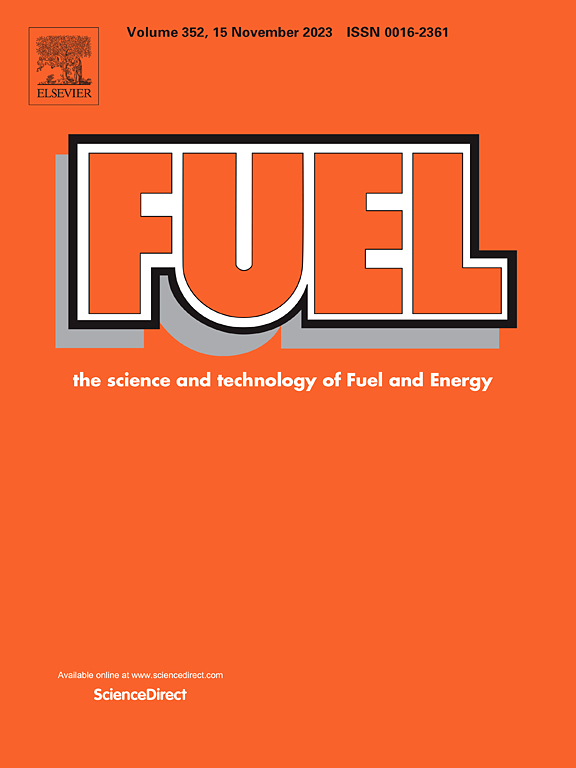Experimental study of spray explosion characteristics and flame propagation in methanol blended water/ethanol
IF 6.7
1区 工程技术
Q2 ENERGY & FUELS
引用次数: 0
Abstract
Methanol, widely used as a fuel and chemical raw material, has a strong affinity for water. Meanwhile, by-products such as ethanol are thermodynamically more stable than methanol, making their formation more favorable. If crude methanol leaks during storage and transportation, it can result in severe spray explosion accidents. Currently, the spray explosion characteristics and flame behavior of methanol containing impurities remain inadequately investigated. Therefore, using a spray explosion experimental system, this study examines the explosion characteristics and flame propagation of methanol under different ignition delay times (IDT) and ambient temperatures (Ta) with varying water/ethanol mass fractions. The explosion characteristics of blended methanol are assessed based on the maximum explosion pressure (pmax), the explosion pressure rise rate (dp/dt), and the maximum explosion pressure arrival time (tp). The results indicate that due to the expansion caused by water evaporation during combustion, a small amount of water can enhance methanol explosions. However, when the water content exceeds 4 %, the suppression effect becomes evident, significantly reducing both p and dp/dt. IDT has a substantial impact on turbulence intensity within the system. At low IDT, strong turbulence leads to a lower pmax, which subsequently rises. When the IDT exceeds 260 ms, droplet aggregation and sedimentation may occur, leading to a reduction in pmax. The tp shows a linear relationship with IDT. Ta promotes the evaporation of gaseous methanol, resulting in increased pmax and dp/dt, both of which show a positive correlation with Ta. Compared with gaseous combustion flames, spray explosion flames exhibit significant instability. Water can effectively inhibit the flame propagation speed of spray explosions. At low IDT, turbulence enhances flame propagation and development, resulting in a greater peak flame propagation speed. An increase in Ta enhances molecular thermal motion, leading to a substantial increase in the average flame propagation speed.
甲醇混合水/乙醇喷雾爆炸特性及火焰传播实验研究
甲醇对水有很强的亲和力,广泛用作燃料和化工原料。同时,副产品如乙醇在热力学上比甲醇更稳定,这使得它们的形成更有利。如果粗甲醇在储运过程中发生泄漏,会造成严重的喷爆事故。目前,对含杂质甲醇的喷雾爆炸特性和火焰行为的研究还不够充分。因此,本研究使用喷雾爆炸实验系统,研究了不同点火延迟时间(IDT)和不同水/乙醇质量分数环境温度(Ta)下甲醇的爆炸特性和火焰传播。根据最大爆炸压力(pmax)、爆炸压力上升速率(dp/dt)和最大爆炸压力到达时间(tp)对混合甲醇的爆炸特性进行了评价。结果表明,由于燃烧过程中水蒸发引起的膨胀,少量的水可以增强甲醇爆炸。但当含水量超过4%时,抑制效果明显,p和dp/dt均显著降低。IDT对系统内湍流强度有很大的影响。在低IDT时,强湍流导致pmax降低,随后上升。当IDT超过260 ms时,可能发生液滴聚集和沉积,导致pmax降低。tp与IDT呈线性关系。Ta促进气态甲醇的蒸发,导致pmax和dp/dt增大,两者与Ta呈正相关。与气体燃烧火焰相比,喷雾爆炸火焰具有明显的不稳定性。水能有效抑制喷爆火焰的传播速度。在低IDT下,湍流增强了火焰的传播和发展,导致火焰的峰值传播速度更快。Ta的增加增强了分子热运动,导致平均火焰传播速度的显著增加。
本文章由计算机程序翻译,如有差异,请以英文原文为准。
求助全文
约1分钟内获得全文
求助全文
来源期刊

Fuel
工程技术-工程:化工
CiteScore
12.80
自引率
20.30%
发文量
3506
审稿时长
64 days
期刊介绍:
The exploration of energy sources remains a critical matter of study. For the past nine decades, fuel has consistently held the forefront in primary research efforts within the field of energy science. This area of investigation encompasses a wide range of subjects, with a particular emphasis on emerging concerns like environmental factors and pollution.
 求助内容:
求助内容: 应助结果提醒方式:
应助结果提醒方式:


